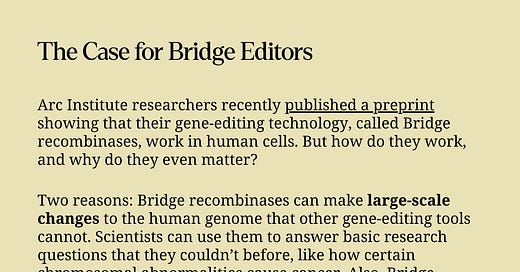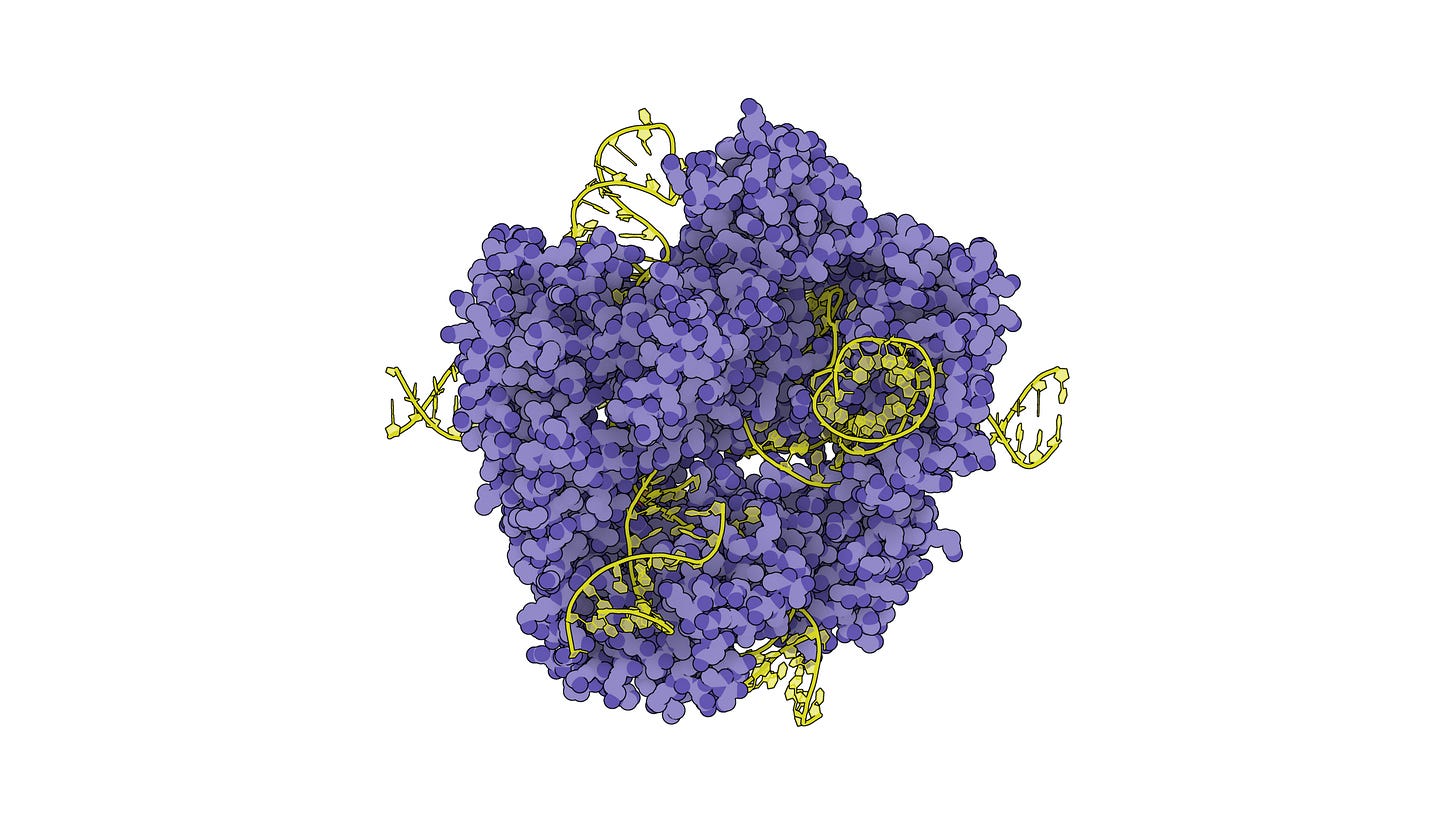Arc Institute researchers recently published a preprint showing that their gene-editing technology, called Bridge recombinases, work in human cells. Many people applauded the paper on social media, while others asked, “Wait, how does this tool even work? And why does it matter?”
Fair questions. The preprint is not easy to understand, and the reasons for inventing a new type of gene-editing tool in 2025 are even less obvious. After all, there are already dozens of CRISPR gene-editing tools to swap ‘letters’ in the genome, delete stretches of DNA, or replace one sequence with another. What makes these recombinases any better?
A few things. But if you don’t care to read on, and just want to hear my quick argument in 280 characters about 65 words, then here it is:
Bridge recombinases can make large-scale changes to the human genome that other gene-editing tools cannot. Therefore, scientists can use them to answer basic research questions that they couldn’t before, like how certain chromosomal abnormalities cause cancer. Also, Bridge recombinases are able to make those big genome changes without relying on cellular repair mechanisms, which could make them more predictable than other gene-editing tools.
So let me explain what a Bridge recombinase is. At its core, it’s a genome-editing tool made from two parts: a protein (called the recombinase) that cuts and rejoins strands of DNA, and a RNA molecule (called the ‘Bridge’) that guides the recombinase to a specific site in a cell’s genome.
Bridge recombinases were discovered in nature; not made in a laboratory. They are a type of transposase, a gene that naturally “cuts-and-pastes” itself into new places in the genome. Transposases are found all over the place, like in plants, bacteria, and animals. Almost half of the human genome is thought to have originated from transposable elements, which get duplicated and move around over millions of years.
Most transposase proteins recognize a specific stretch of DNA and always insert their transposable elements at that particular sequence. This means that it is very difficult to “reprogram” most transposase proteins.
But last June, Arc Institute researchers described a family of naturally occurring transposases, called IS110, that rearrange DNA using an unusual mechanism. Unlike most transposases, which recognize DNA through protein binding, IS110 transposases use small RNA molecules (called "Bridge RNAs") instead.
In nature, these Bridge RNAs attach to two DNA sequences at the same time: one at the target location where the insertion occurs, and one within the transposon itself (the "donor DNA"). By bridging these two sequences, the Bridge RNA instructs the recombinase protein to cut and paste the transposon at the desired location. The Arc scientists showed that they could modify these Bridge RNAs to instruct the recombinase to edit other locations in the genome, too—not just the transposon's original site. These scientists found two recombinases in this IS110 family (called IS621 and IS622) that can be used to edit large chunks of DNA in bacterial or human cells, respectively.
Now, at this point you may be wondering: “OK, so that’s it? Bridge recombinases can edit genomes, but why not just use CRISPR-Cas tools to do that instead?” And the answer is this: The special thing about Bridge recombinases is that they edit the genome without relying on cellular repair mechanisms, unlike CRISPR-based tools.1
Since 2012, scientists have discovered all kinds of Cas proteins with various numbered names, like Cas9 and Cas12 and Cas13 and even (my favorite) Cas7-11. Researchers have also invented lots of CRISPR “spin-offs,” such as base editors and prime editors. Of all the CRISPR gene-editing tools available, prime editors are perhaps the most versatile. Prime editors can make lots of different types of edits to a genome, like swap one nucleotide for another (say, A → C), insert short sequences, or delete segments of DNA. These edits are usually short, though—typically 40–80 nucleotides, and rarely longer than 100 nucleotides.2
All CRISPR gene-editing tools share a flaw, though: they rely on cell repair pathways to make their edits. If a researcher wants to permanently “shut down” a gene, for example, they might use CRISPR-Cas9. The Cas9 protein goes into the genome and makes a cut at the position indicated by its guide RNA. But the Cas9 protein itself doesn't then fix the DNA it has broken. The cell has to fix that damage a different way.
Cells have two main ways to fix DNA breaks. Non-homologous end joining quickly slaps the two broken strands together, often adding or deleting random bits of DNA in the process. It is messy, but fast. The second option, homology-directed repair, uses a matching DNA template to fix the break. Basically, scientists can introduce a DNA "donor template" into cells alongside CRISPR-Cas9. The cell sees this template as the correct version of the sequence and copies from it to fix the break. But homology-directed repair only works reliably during specific phases of the cell cycle and happens less frequently than non-homologous end joining.
Because CRISPR relies on these cellular repair pathways, its edits are inherently unpredictable.3 Cellular repair systems are non-deterministic (sometimes the cell uses one option, and sometimes it uses the other), and different cells therefore produce different results. Bridge recombinases bypass these cellular pathways, which could make their edits more predictable.4
Which brings me, finally, to the last question: “OK, so Bridge recombinases are perhaps more reliable than CRISPR tools, and they can make larger types of edits to the genome. But how can we actually use these things in the real-world?”
In a few different ways. For their recent preprint, researchers used a Bridge recombinase to precisely invert a 930,000 base-pair sequence in human cells, and also to chop out 130,000 bases in a single go. They also used Bridge recombinases to edit a gene linked to a disease called Friedreich’s ataxia. Whereas healthy people have several repeats of a sequence—GAA—in a gene called FXN, people with Friedreich’s ataxia have hundreds or thousands of the repeats. This causes the gene to make a defective protein that, in turn, slowly causes nerve damage. In a cell culture model, the researchers used a Bridge recombinase to cut out more than 80 percent of the repeating sequences (and it worked about 40 percent of the time.)
Now let’s zoom out and think about bigger applications for these Bridge recombinases. I can think, almost immediately, of two uses. The first is to study cancer in the laboratory, and the second is to quickly make transgenic mouse models for preclinical trials.
There are many types of cancers caused by large-scale genome rearrangements. Chronic myeloid leukemia, for example, happens when chunks of chromosomes 9 and 22 swap places. Using Bridge recombinases, researchers could recreate this rearrangement in healthy cells to study how it causes disease and how to reverse it. Ditto for Ewing’s sarcoma, a bone cancer caused by another type of chromosome fusion.
Bridge recombinases could also make it much simpler to make transgenic mice. Millions of mice are used in biology research each year. But historically, researchers would spend many months or years making just one transgenic mouse because the main technology to do—called Cre-loxP—is such an obnoxious pain to work with.
Cre-loxP is a genetic tool that uses an enzyme, called Cre recombinase, to cut and rearrange DNA sequences located between specific DNA markers, called loxP sites. (In other words, Cre recombinase cuts DNA, but only at places in the genome containing these little DNA markers. Cre recombinases are therefore not programmable in the same way as a Bridge recombinase.)
So to make a mouse model, scientists engineer one mouse line to have loxP sites flanking the gene of interest. Then, they engineer another mouse line to make the Cre recombinase. After breeding these two mouse lines together, the offspring inherit both the Cre protein and the loxP-flanked DNA. Only at that point can Cre recombinase finally rearrange or remove the DNA between the loxP sites. Each genetic change requires a new set of loxP insertions and many additional breeding cycles.
With Bridge recombinases, much of this tediousness goes out the window. Instead of spending months making custom mouse lines with loxP sites, researchers can just design a single Bridge RNA and inject that RNA and the bridge recombinase protein, together, into embryos. The bridge RNA pairs with the DNA targets, and the recombinase rearranges the genome right there, in one step. No separate mouse lines, no extended breeding cycles, no pre-installed DNA sequences.
There are other uses for Bridge recombinases, too. Scientists can use them to make just about any type of large-scale edits, which means that “genome design” is now an actual possibility. And so maybe the questions we started with—"How does this work? Why is it better?"—aren't even the right ones.
For decades, biologists have mainly been observers; cataloging genes, making little mutations; mapping chromosomes; knocking stuff out and trying to put piecemeal observations together again. But now, for the first time, there is a tool good enough to rewrite large stretches of the human genome. So the questions worth asking have changed. Instead of wondering what these tools can do, we should start thinking about what we want them to do.
Thanks to Nicholas Perry and Matt Durrant for reading drafts of this.
There is most likely a 2 bp flap that remains after recombination using the Bridge system. This can probably be mitigated depending on how scientists design the target and donor sequences. But in most cases it would require cellular processes to repair that 2 bp flap, according to an author of the preprint, Matt Durrant.
There are more advanced forms of prime editing, but they are out of scope for this article. David Liu’s group has used prime editors to insert recombinase “landing sites” in a genome, and then use recombinases to make gene-sized inserts. But in general, prime editors alone are only able to modify ~100 bases of DNA at once.
Prime editors get around these two major repair pathways, but still rely on a cell’s machinery (the mismatch repair pathway) to fix the damage and make the edit.
Another benefit is that the DNA sequence Bridge recombinases insert is fully programmable, enabling nearly scarless genome edits. In contrast, prime editing paired with recombinases or CRISPR-associated transposases (CAST systems) rely on large recombinase recognition sequences—typically 30-50 nucleotides—that cannot be customized. These large, fixed recognition sequences make it difficult to do precise insertions, especially within things like exons.






Very interesting! However, I think the most relevant comparison is not to something like a base or prime editor but to PASSIGE (covered briefly in a footnote here, and it does rely on prime editing hence DNA repair, so okay I guess it's different) or more directly to CASTs (CRISPR-associated transposases) which also make scarless DSB-free gene-size insertions (https://www.science.org/doi/10.1126/science.adt5199). It seems like bridge editing maybe more useful for making mouse models, but it seems like the potential therapeutic advantages over CASTs are pretty minor. Am I missing something?
For mouse models it makes little difference for now, at least not at current efficiencies. This is also somewhat conditional on our ability to make a stable transposase protein, hasn't always been easy in this field. You can get arbitrarily large deletions relatively efficiently with regular Cas9 (~10%) and then just breed mice with the correct genotype.
Once installed, Cre/loxP is typically near 100% efficient and used for more complex studies - I can't think of anyone who would use it these days just to make a deletion mouse line. With Cre/loxP you will typically induce a specific rearrangement in specific cell types or at specific timepoints - can't do that with bridge editors until they get really very efficient. BrEs might be a great tool in therapeutic contexts though, where efficiency is (relatively) less important than safety.